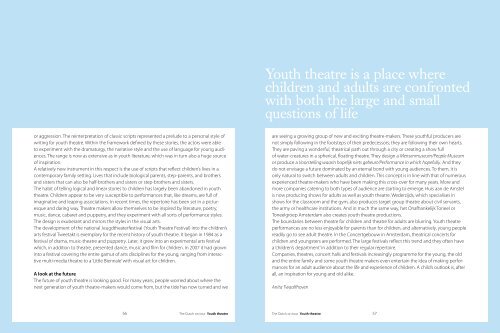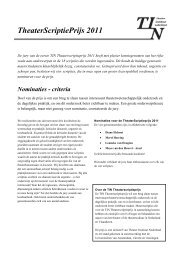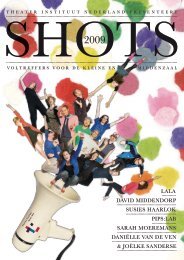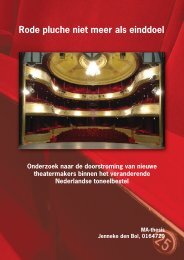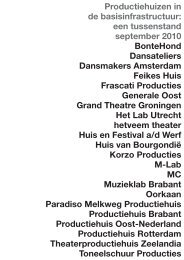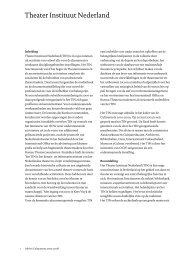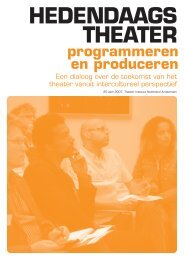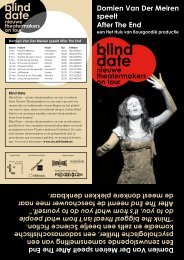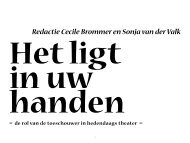T H E D U T C H O N T O U R - Theater Instituut Nederland
T H E D U T C H O N T O U R - Theater Instituut Nederland
T H E D U T C H O N T O U R - Theater Instituut Nederland
You also want an ePaper? Increase the reach of your titles
YUMPU automatically turns print PDFs into web optimized ePapers that Google loves.
Youth theatre is a place where<br />
children and adults are confronted<br />
with both the large and small<br />
questions of life<br />
or aggression. The reinterpretation of classic scripts represented a prelude to a personal style of<br />
writing for youth theatre. Within the framework defined by these stories, the actors were able<br />
to experiment with the dramaturgy, the narrative style and the use of language for young audiences.<br />
The range is now as extensive as in youth literature, which was in turn also a huge source<br />
of inspiration.<br />
A relatively new instrument in this respect is the use of scripts that reflect children’s lives in a<br />
contemporary family setting. Lives that include biological parents, step-parents, and brothers<br />
and sisters that can also be half-brothers and sisters or step-brothers and sisters.<br />
The habit of telling logical and linear stories to children has largely been abandoned in youth<br />
theatre. Children appear to be very susceptible to performances that, like dreams, are full of<br />
imaginative and leaping associations. In recent times, the repertoire has been set in a picturesque<br />
and daring way. Theatre makers allow themselves to be inspired by literature, poetry,<br />
music, dance, cabaret and puppetry, and they experiment with all sorts of performance styles.<br />
The design is exuberant and mirrors the styles in the visual arts.<br />
The development of the national Jeugdtheaterfestival (Youth Theatre Festival) into the children’s<br />
arts festival Tweetakt is exemplary for the recent history of youth theatre. It began in 1984 as a<br />
festival of drama, music-theatre and puppetry. Later, it grew into an experimental arts festival<br />
which, in addition to theatre, presented dance, music and film for children. In 2007 it had grown<br />
into a festival covering the entire gamut of arts disciplines for the young, ranging from interactive<br />
multi-media theatre to a ‘Little Biennale’ with visual art for children.<br />
A look at the future<br />
The future of youth theatre is looking good. For many years, people worried about where the<br />
next generation of youth theatre-makers would come from, but the tide has now turned and we<br />
are seeing a growing group of new and exciting theatre-makers. These youthful producers are<br />
not simply following in the footsteps of their predecessors; they are following their own hearts.<br />
They are paving a wonderful, theatrical path out through a city or creating a show full<br />
of water-creatures in a spherical, floating theatre. They design a Mensenmuseum/People Museum<br />
or produce a Voorstelling waarin hopelijk niets gebeurt/Performance in which hopefully. And they<br />
do not envisage a future dominated by an eternal bond with young audiences. To them, it is<br />
only natural to switch between adults and children. This concept is in line with that of numerous<br />
experienced theatre-makers who have been making this cross-over for many years. More and<br />
more companies catering to both types of audience are starting to emerge. Huis aan de Amstel<br />
is now producing shows for adults as well as youth theatre. Wederzijds, which specialises in<br />
shows for the classroom and the gym, also produces target group theatre about civil servants,<br />
the army or healthcare institutions. And in much the same way, het Onafhankelijk Toneel or<br />
Toneelgroep Amsterdam also creates youth theatre productions.<br />
The boundaries between theatre for children and theatre for adults are blurring. Youth theatre<br />
performances are no less enjoyable for parents than for children, and alternatively, young people<br />
readily go to see adult theatre. In the Concertgebouw in Amsterdam, theatrical concerts for<br />
children and youngsters are performed. The large festivals reflect this trend and they often have<br />
a ‘children’s department’ in addition to their regular repertoire.<br />
Companies, theatres, concert halls and festivals increasingly programme for the young, the old<br />
and the entire family and some youth theatre makers even entertain the idea of making performances<br />
for an adult audience about the life and experience of children. A child’s outlook is, after<br />
all, an inspiration for young and old alike.<br />
Anita Twaalfhoven<br />
56 The Dutch on tour Youth theatre<br />
The Dutch on tour Youth theatre<br />
57


